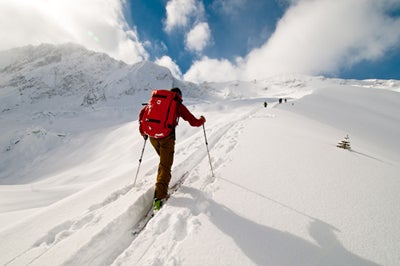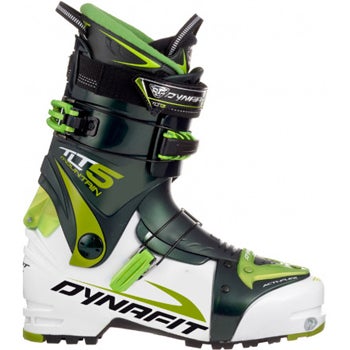
By Stephen Regenold
Photos by Tommy Chandler/Backcountry.com.
Last time I checked, the live countdown clicker read “1,749,615.” That was the current readout on , a number that represents vertical feet skied in the backcountry this year by Greg Hill, a 34-year-old Revelstoke, B.C., man on a mission. Hill's goal is to ski two million total vertical feet by his own power during the calendar year of 2010.
Essentially, this means Hill has to ascend and ski backcountry mountains nearly every day as his job. He does much of this “work” in and around the mountains above his home in Revelstoke. But he's traveled as far as Alaska and South America this year as well in search of an endless winter and more and more mountains to climb and ski.
Hill said he skis 10,000 vertical feet on an average day with multiple runs. That's ascending 10,000 feet up in total, pulling the skins off his skis, then tearing collectively 10,000 feet back down over the day toward home. His record is 50,000 feet in a 24-hour period, making Hill one of the speediest and sickest backcountry practitioners to ever clip into a pair of AT boards.

The details of Hill's descents are documented on his website and blog. I interviewed Hill last week not to talk high faces and powder turns but ski equipment and gear. Hill is a gear junkie, no doubt, and a consummate equipment expert as well. With years of trial and error through hundreds of days on the snow — and with the aid of sponsor companies like Backcountry.com, Arc'teryx, Dynafit and Polartec — Hill has assembled an arsenal of backcountry apparel and gear he says represents the current industry state of the art.
His favorite piece of gear all around? The Dynafit TLT 5 boot was a top mention. This alpine-touring (AT) boot is so light and agile Hill calls them his “Peter Pan boots.” “I can literally run in them,” he said. With a skimmed-down design, including two buckles and a Velcro strap, the TLT 5s weigh just over 2.5 pounds per foot. Hill says the boots' light and comfortable fit are key to enabling him to climb and ski day after day.
His ski situation, all from sponsor Dynafit, include the TLT 5 boots as well as the company's Stoke ski and the TLT vertical ST bindings. Depending on conditions and terrain type, he might pull Dynafit's Manaslu or Seven Summits skis out of his quiver.
For base layers, Hill wore merino wool for years. He recently switched back to a synthetic base system made by Arc'teryx. The Phase bottoms have fibers encapsulated with a silver-ion material, and Hill says they stay drier than merino and have the same kind of wear-'em-five-days-straight odor resiliency as wool.
听

Hill suits up in outerwear from Arc鈥檛eryx, including hard- and soft-shell jackets like the company's Gamma MX jacket with Polartec Power Shield fabric and the GORE-TEX-based Alpha SV.
He has also been testing the to-be-released GORE-TEX听Active Shell, a hardshell face fabric W.L. Gore & Associates touts as its most breathable technology to date. Active Shell is waterproof and windproof, but the membrane is half the weight of previous听GORE-TEX听versions. Hill's test so far has been positive, and he says he can wear Active Shell longer as it breaths better than his existing systems.
I asked Hill about gear that fails on his days in the hills. He claims his system is so dialed that things rarely go wrong on the gear front, though he did note climbing skins failing when it's too cold. In Canada, where temps can dredge below zero on regular winter days, Hill said the adhesive on his climbing skins becomes less effective and the skins can slip.
Other random and interesting gear includes Backcountry.com's Dawn Patrol Vacuum Coffee Tumbler, the Mammut Pulse Barryvox Avalanche Beacon, Black Diamond's Raven Pro Ice Axe, a Petzl Tibloc emergency ascender, and a helmet camera from V.I.O. Inc. He wears a simple ball cap to keep the sun off when it's warm.
The year's altitudinal progress is tracked on a Suunto X6 HR watch, a trusty tool he wears every day. Its built-in barometric altimeter counts feet gained on the climb and skied on the descent. He stores the totals on the watch as well as in a logbook for backup at home, with 1,749,615 feet tabulated thus far. Says Hill, “I keep a backup on my computer just in case.”
–Stephen Regenold is founder and editor of . You can monitor Greg Hill's progress at .
听
听